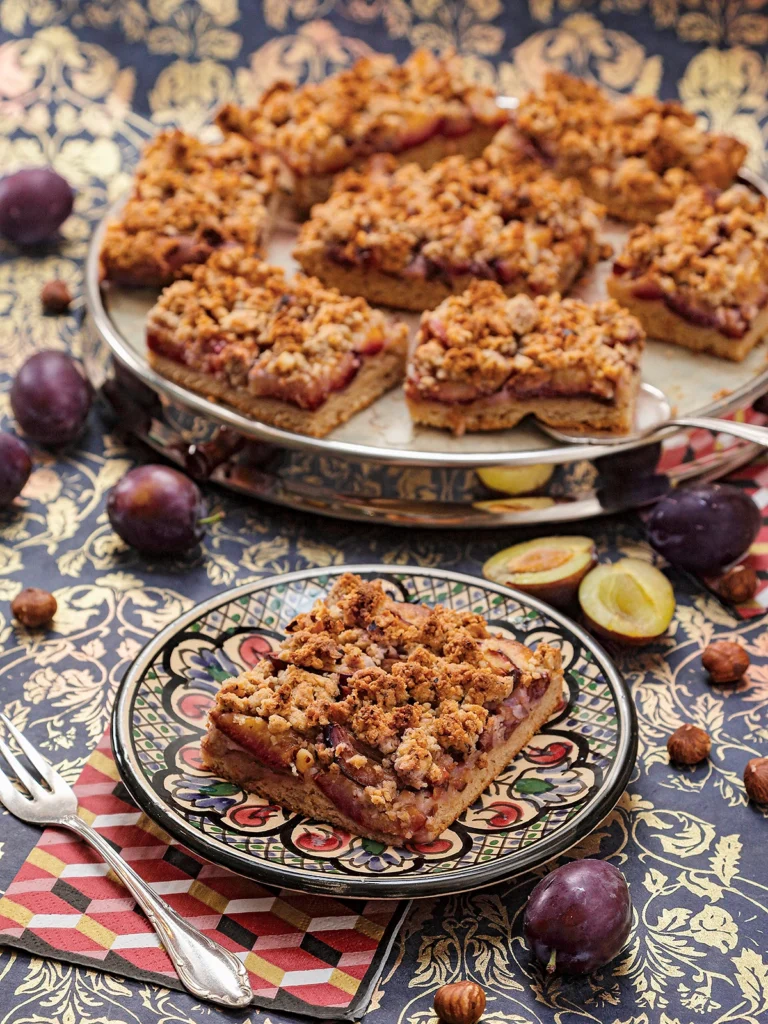
A seasonal delicacy is on the cake table: the German plum cake! The family is always delighted with this juicy fruit cake from the tray. It’s made from a yeast dough that is covered with a lot of plums. I didn’t use refined sugar but my favorite sweetener, Medjool dates. This year, I spiced it up with a hazelnut crumble, which was a great idea. You should try this one! It is simple to make, and all you need is a bit of time to let the yeast grow and to prepare the plums!
Ingredients for making German Plum Cake:
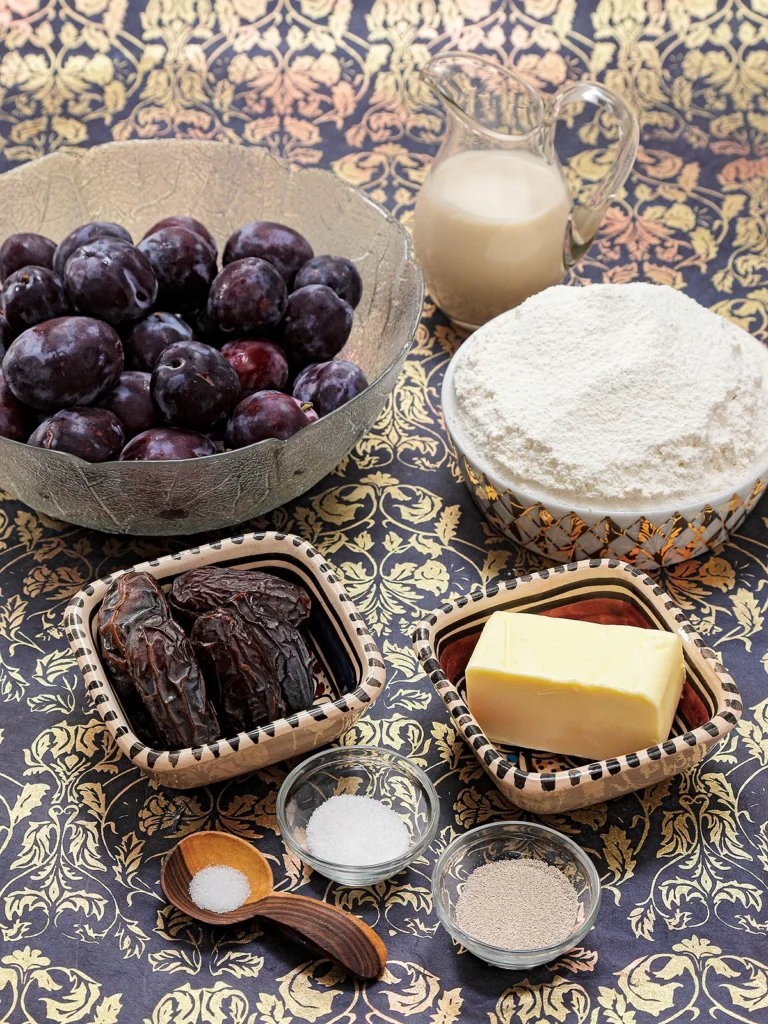
Dough:
- Plums
- Spelt flour
- Butter substitute
- Dates (or sugar)
- Oat milk
- Dry yeast

Crumble:
- Spelt flour
- Butter substitute
- Maple syrup
- Ground hazelnuts
- Chopped hazelnuts
- Ceylon cinnamon
- Pinch of salt
The crumble is optional. Even without it, this German plum cake is still tasting delicious.
How to make German Plum Cake:
Here’s a short tutorial video that quickly explains the recipe:
Making the Yeast Dough and Preparing the Plums:
At first, add the oat milk in a saucepan and warm it just a little, don’t let it come to a boil. Now, chop the dates, add them, and let them soak. Then, blend the mixture until no pieces of dates are visible.
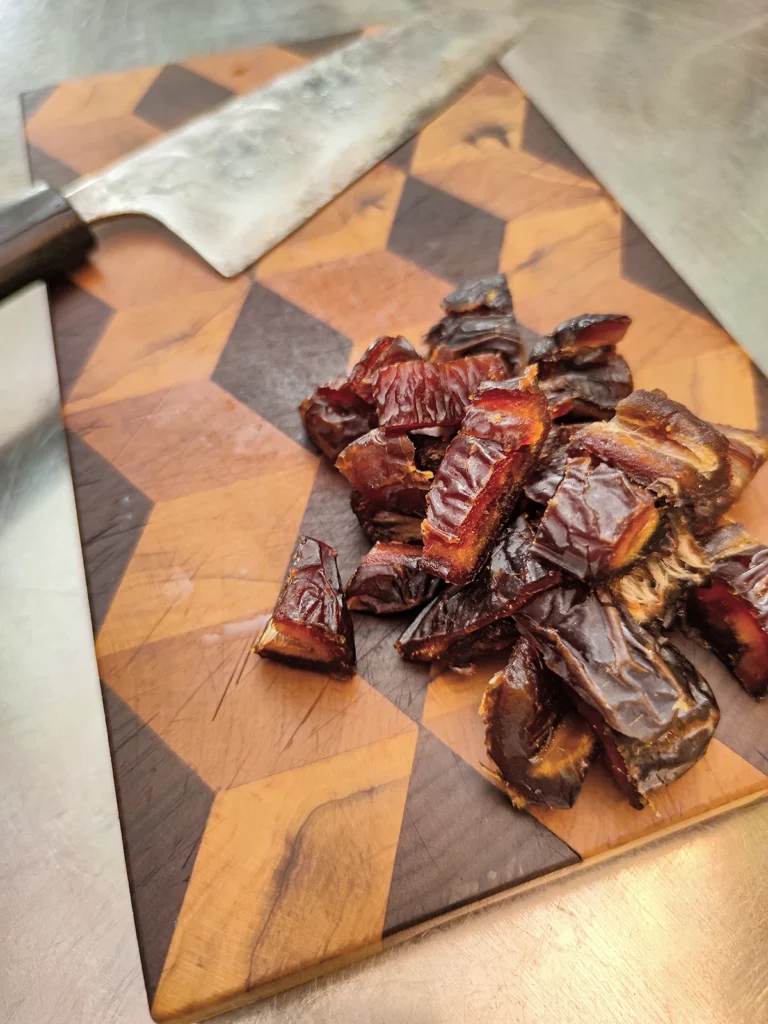
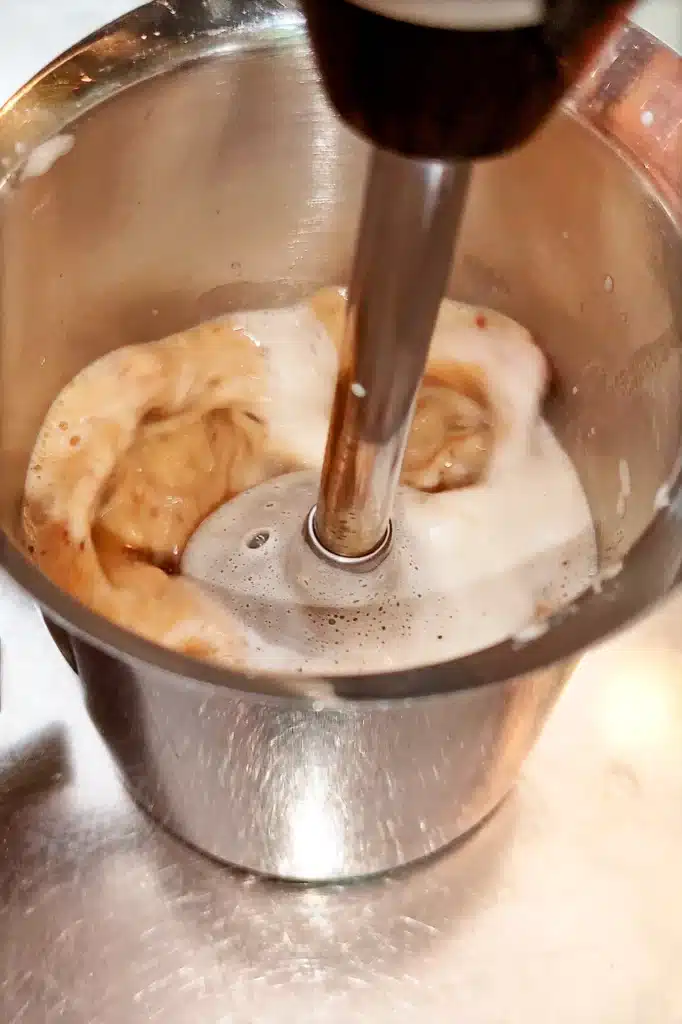
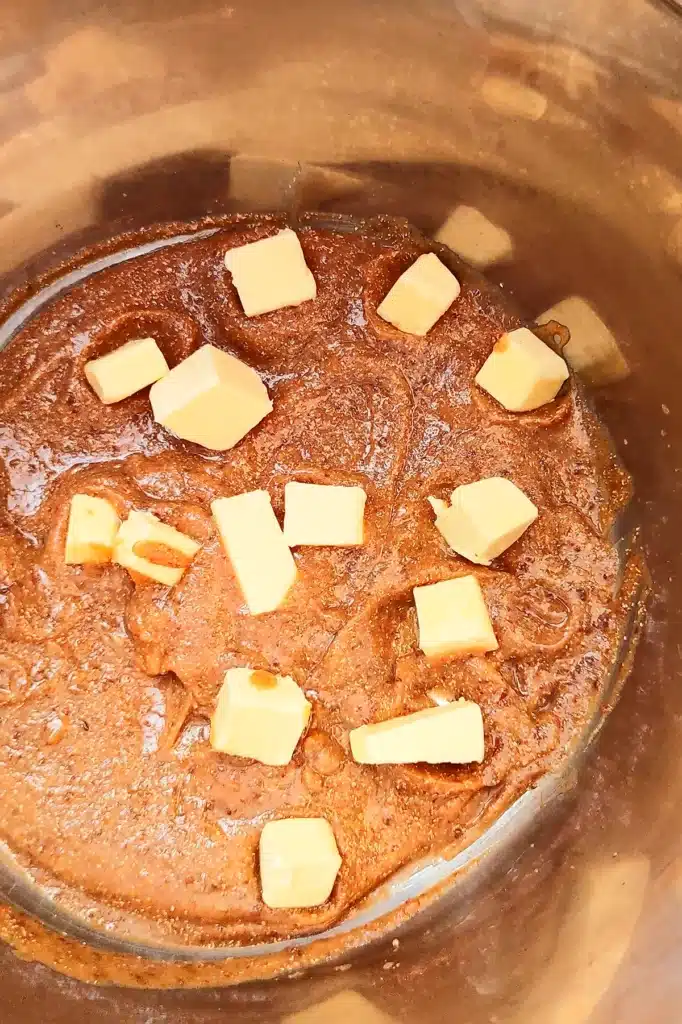
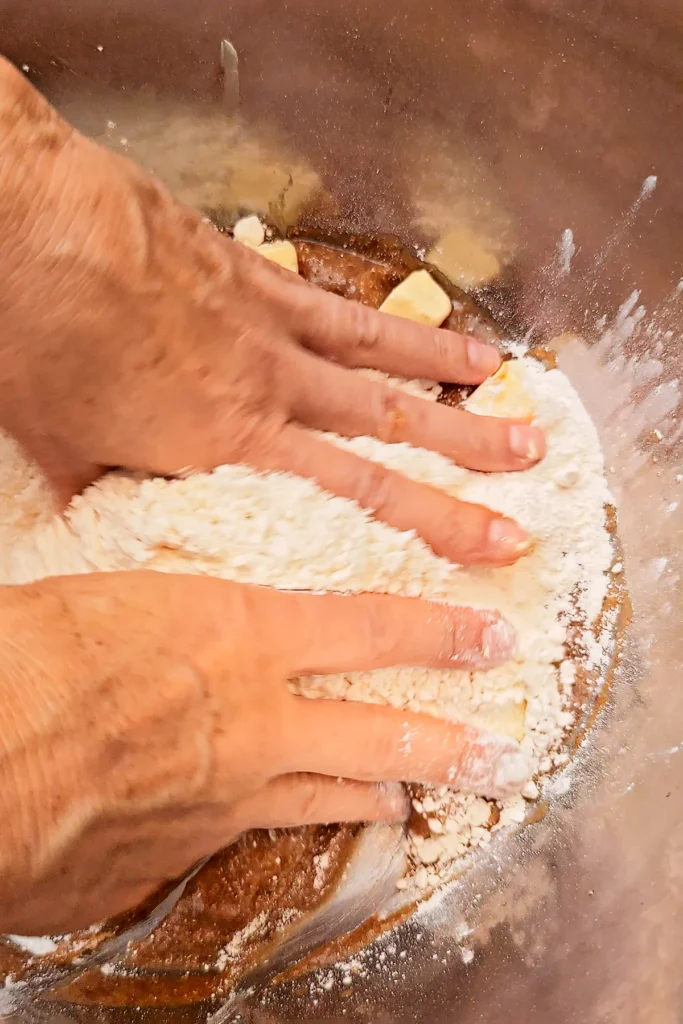
Choose a large mixing bowl, as our yeast dough will at least double in size! Pour our freshly warm blended sweet mixture, add the dry yeast, let it dissolve, and then add the pieces of butter substitute and the flour. I like to knead the dough with my hands – if it gets too sticky, sprinkle a little more flour over it. Start kneading until you feel that all the butter pieces have dissolved and you have an elastic dough.
Make it Comfortable for the Yeast:
I covered the bowl with a clean, slightly dampened kitchen towel (the dough surface shouldn’t dry out) and let the dough rise in a warm place for 1-2 hours until it has doubled in volume. In the summer season, it is warm enough at room temperature – yes, you have to make it comfortable for the yeast (it’s a living unicellular fungus) so it can multiply and grow! If it is too cool in your room, put the yeast dough in the preheated oven at maximum 30°C (90°F). The yeast will feel comfortable and can rise well. I have had good results with dry yeast, but you can also use fresh yeast. In that case, add the fresh yeast to the oat milk mixture and let it dissolve.
In the meantime, we can prepare the plums. Wash them, remove the pit, and cut every fruit into quarters.
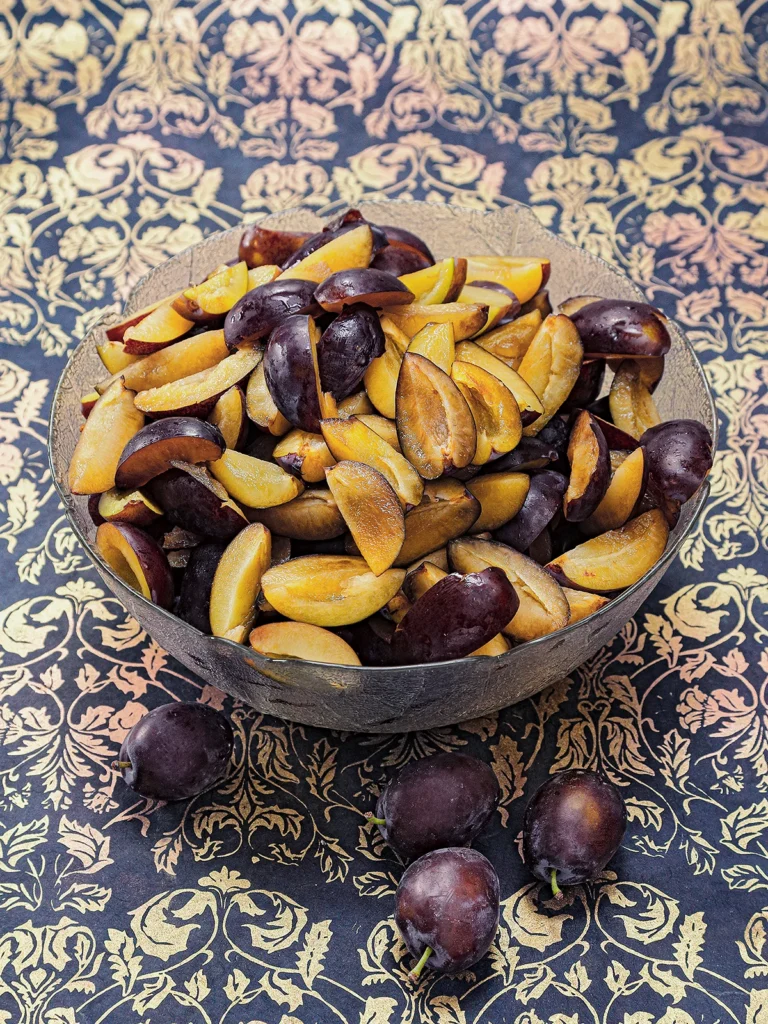
You can prepare a baking tray when the dough has risen nicely.
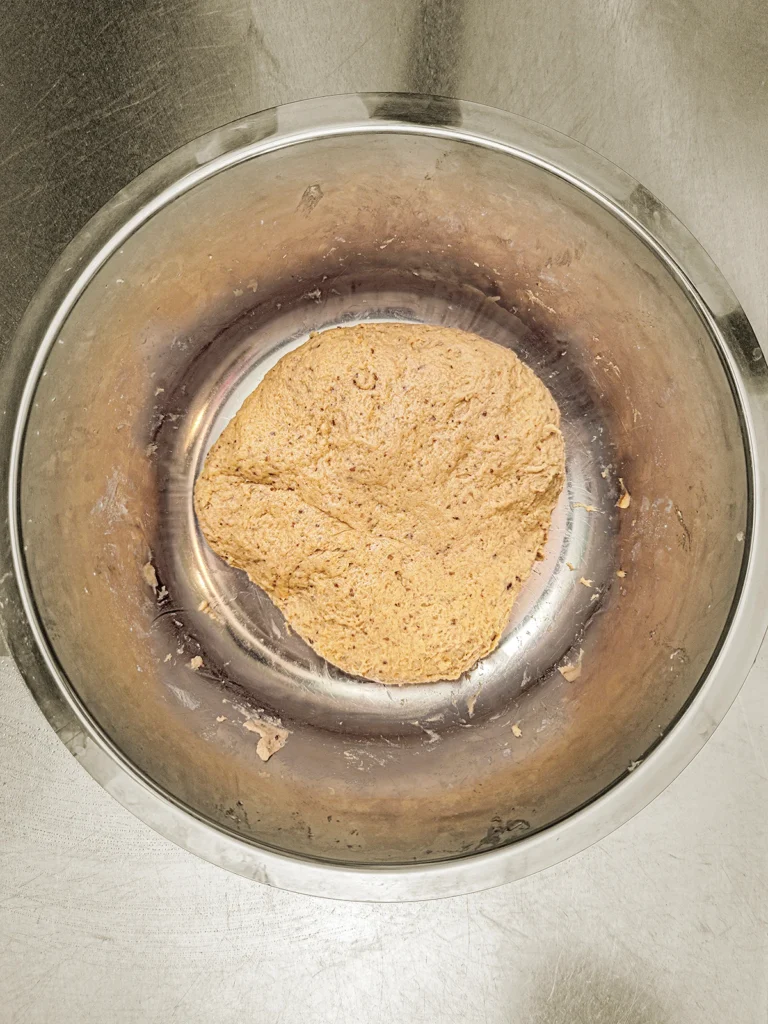
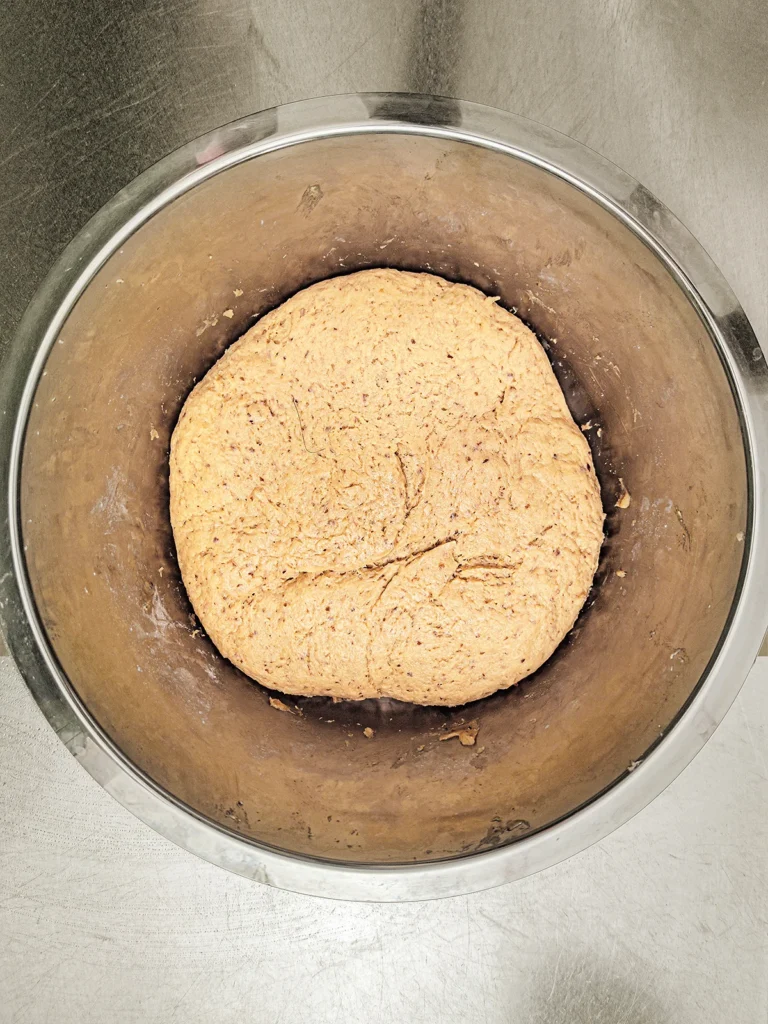
Spread the dough evenly on the tray with your hands until you have a flat dough. Now, the yeast needs another rest for 20 minutes.
It’s time to preheat the oven to 180°C (350°F).


After the dough has risen again after the resting time, we can take care of to the plums. Try to fully cover the dough with fruit. When topping the dough with the plums, place the quartered fruit with the skin side down. The plum peel prevents the dough from becoming soggy so quickly due to fruit juice.
Making the Hazelnut Crumble:
Start to prepare the crumbles while the yeast dough is rising.
Cut the butter substitute into pieces and let it soften at room temperature. Now, put the butter and all other ingredients in a bowl and knead by hand until we can form a round dough ball.
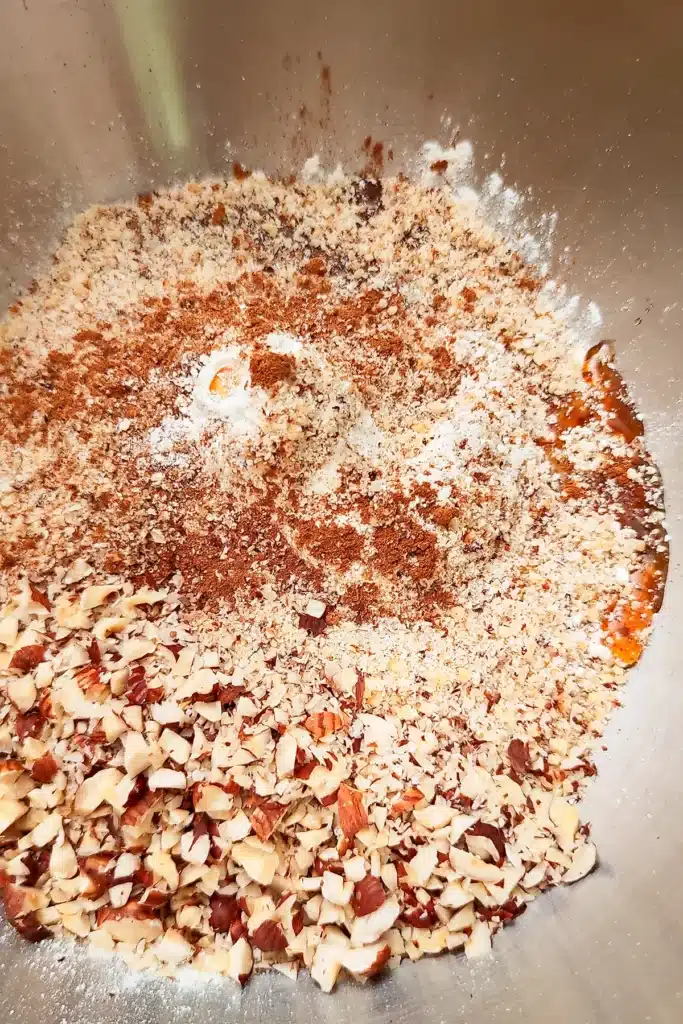
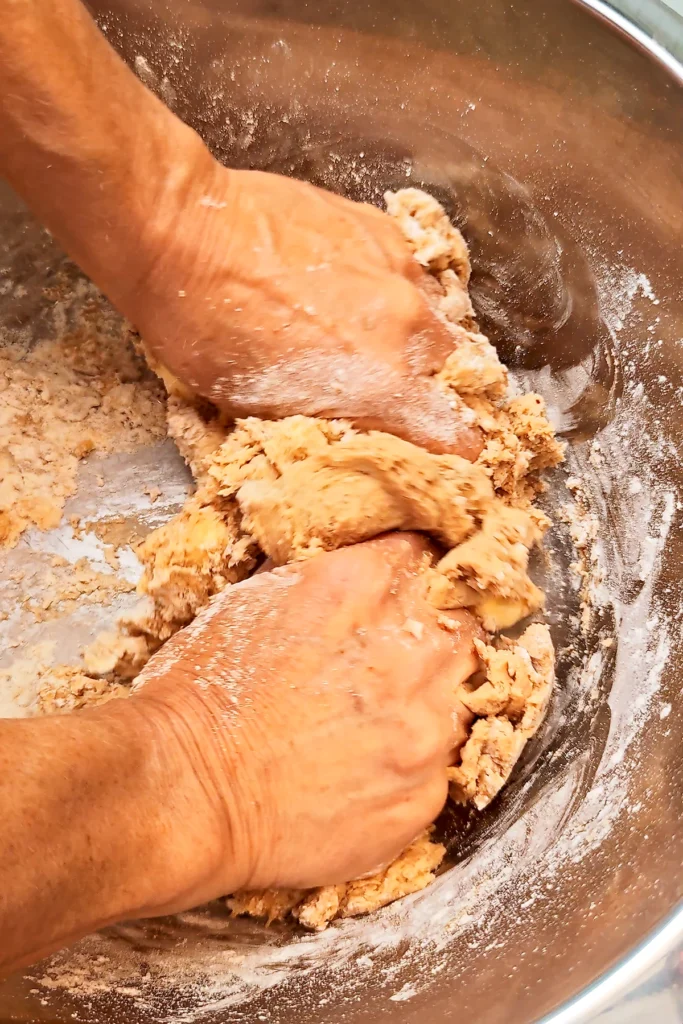
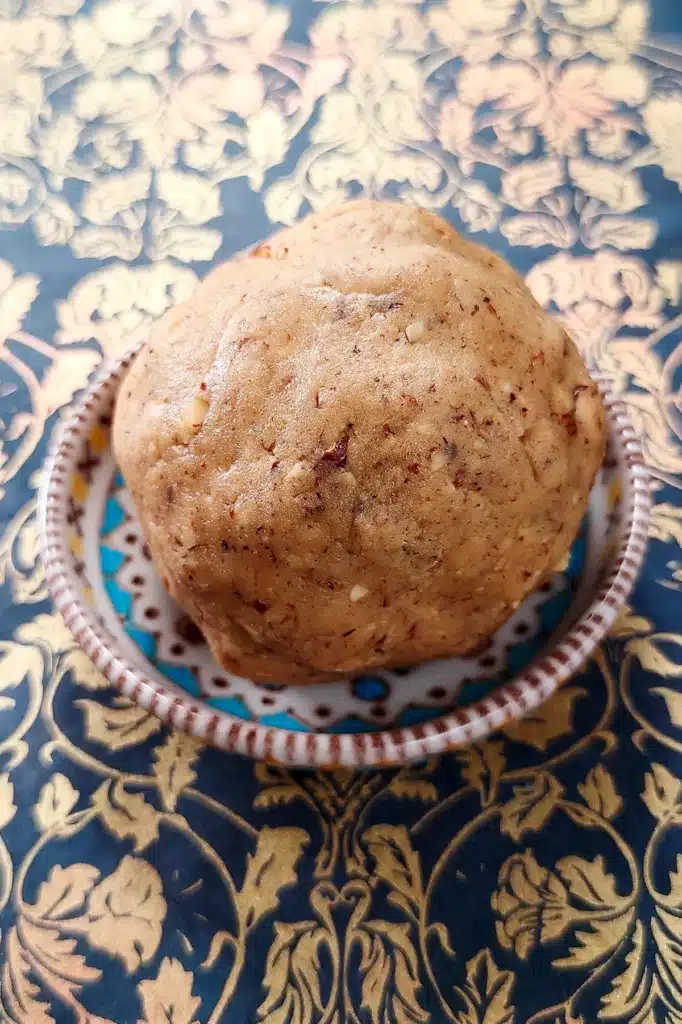
The dough feels completely different than the yeast dough; it should be dry and crumbly. Place them on a plate and let the dough ball rest in the fridge for 30 minutes so the starch can settle and the fat becomes hard – you can make great crumbles from it!
Then we take the dough ball, divide it in half, and crumble it by fingers all over our plum cake.
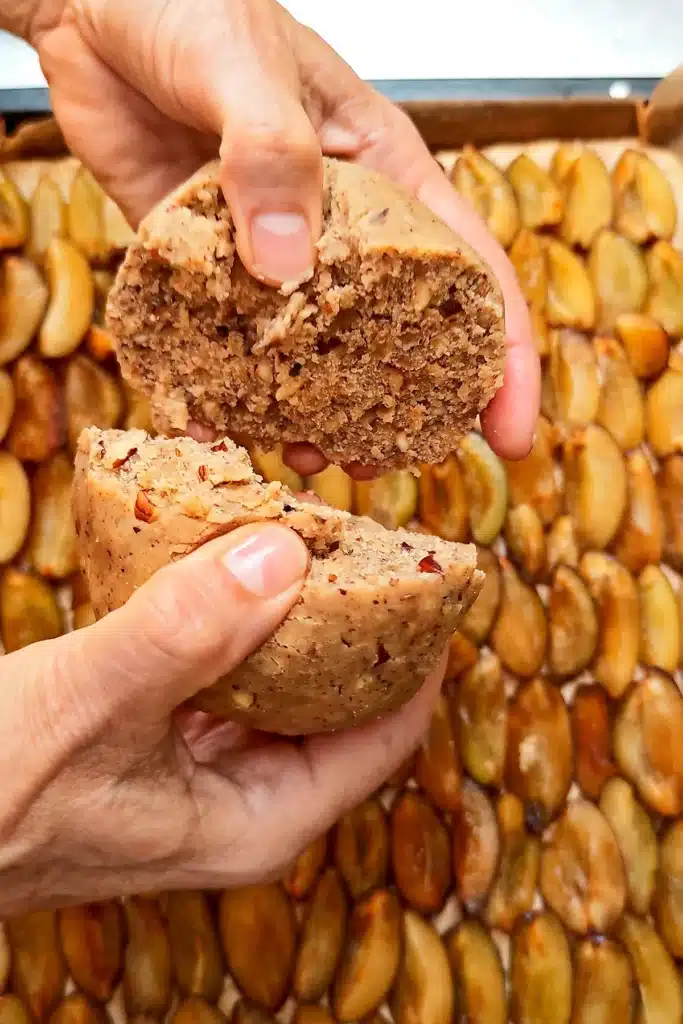
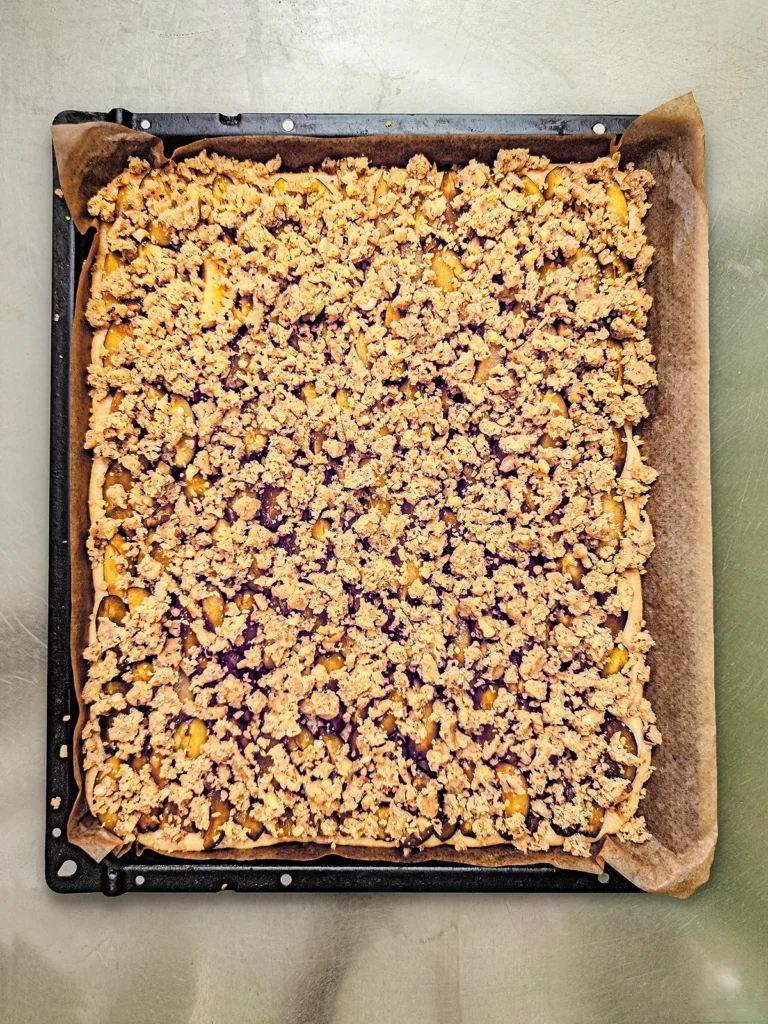
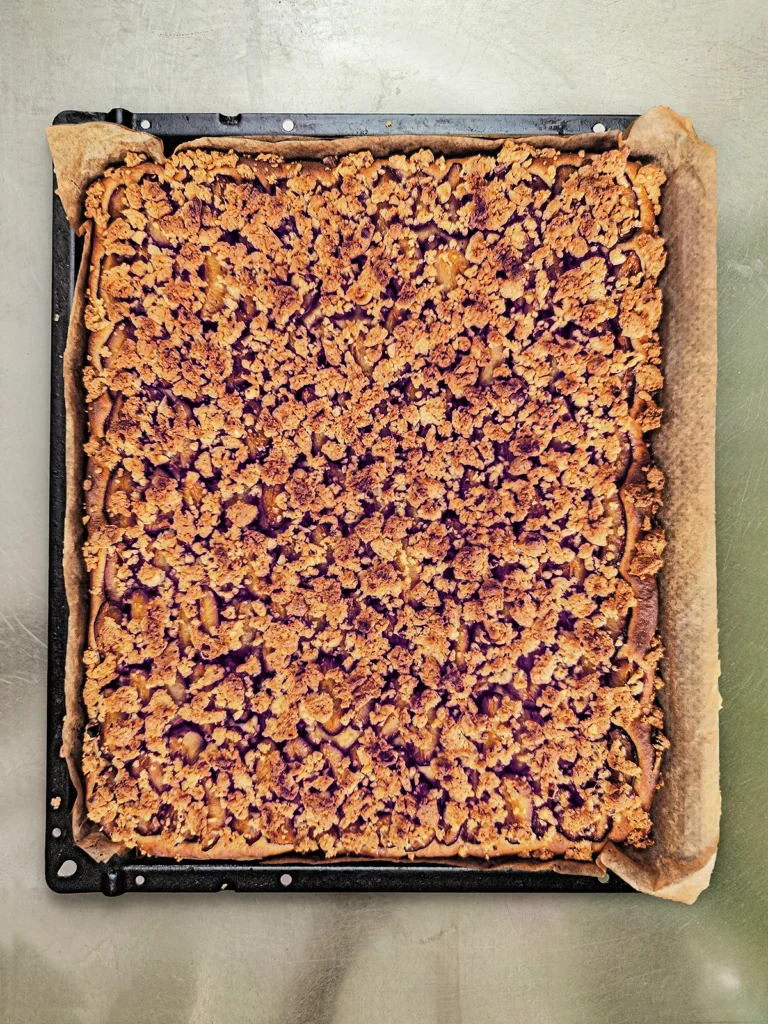
Finally, we put the plum cake in the oven for 35 minutes at 180°C (350°F)top/bottom heat (160 °C/320°F circulating air).
Let it cool down a bit, and then serve it still warm! It’s delicious with whipped cream or vanilla ice cream!
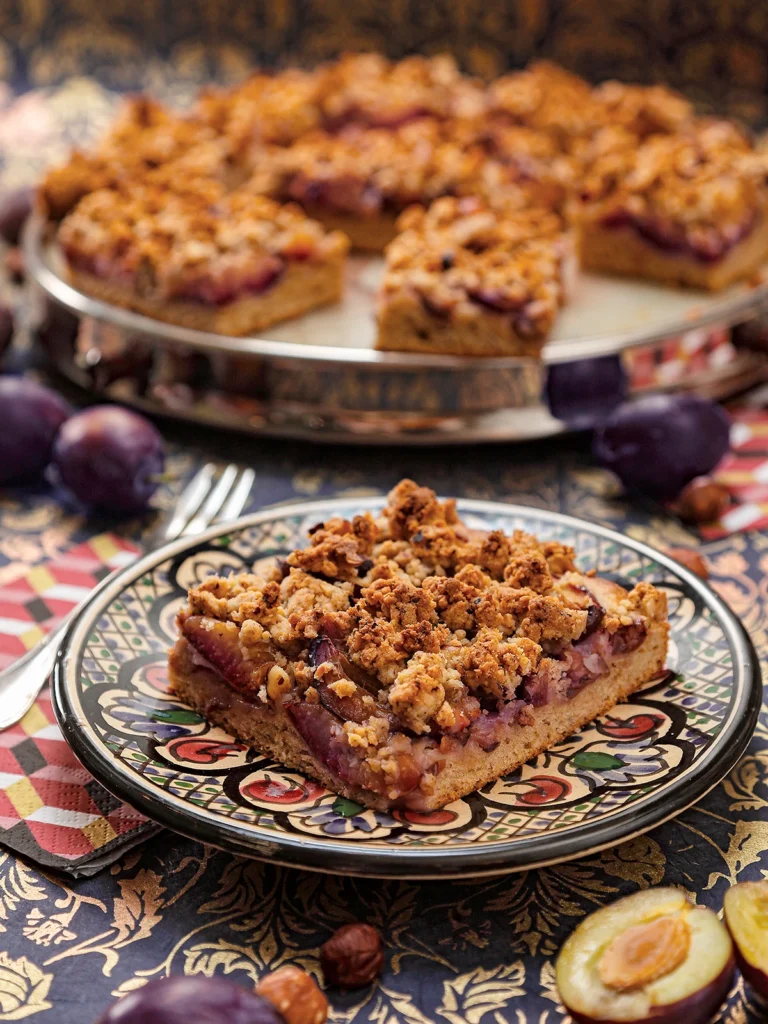
German Plum Cake FAQ:
The german plum cake can be frozen and stored for up to 6 months.
I hope you enjoyed this German plum cake recipe. Let me know what you think in the comments below!
Some Recipe Suggestions:
- Plum popsicles
- Vegan Strawberry Cake
- Yeast Cake with Sea Buckthorn
- Coffee Banana Bread
- Hummus Hazelnut Cake
- Vegan Banana Bread Recipe (Simple & Delicious)
- Vegan Persimmon Tarts
- Sweet Pull Apart Bread

German Plum Cake (with Hazelnut Crumble)
A seasonal delicacy on the cake table: the German plum cake! It is made from a yeast dough that is covered with a lot of plums. For the dough I use dates as my favorite sweetener. I spiced the plum cake up with a hazelnut crumble on top. You should try this one!
- Total Time: 3 Hours
- Yield: 12 Pieces 1x
Ingredients
Dough
- 1000g plums
- 400g spelt flour
- 100g butter substitute
- 200g dates = 8 Medjool dates (or 100g sugar)
- 200ml oat milk
- One bag of dry yeast
Crumble
- 180g spelt flour
- 80g butter substitute
- 80ml maple syrup
- 80g ground hazelnuts
- 40g chopped hazelnuts
- 0,5 tsp ceylon cinnamon
- Pinch of salt
Instructions
Making the Yeast Dough and Preparing the Plums:
Melt the butter substitute in a saucepan.
Add the oat milk and warm it just a little. Don’t let the mixture come to a boil.
Chop the dates, add them, and let them soak.
Blend the mixture until no pieces of dates are visible.
Choose a large mixing bowl, pour in our warm blended mixture, add the dry yeast (you can also use fresh yeast) let it dissolve, and then add the flour.
Start kneading until you have an elastic dough.
Cover the bowl with a clean, slightly dampened kitchen towel and let the dough rise in a warm place for 1-2 hours until it has doubled in volume.
In the meantime prepare the plums. Wash them, remove the pit, and cut every fruit into quarters.
Prepare a baking tray, spread the dough evenly on the tray with your hands until you have a flat dough. Now, the yeast needs another rest for 20 minutes.
Preheat the oven to 180°C/350°F.
We fill on as many plums as possible. When topping the dough with the plums, place the quartered fruit with the skin side down. The dough won’t get soggy so quickly due to fruit juice like this.
Making the Hazelnut Crumble:
Start to prepare the crumbles while the yeast dough is rising.
Cut the butter substitute into pieces and let it soften at room temperature.
Put the butter and all other ingredients in a bowl and knead by hand until we can form a round dough ball. Let the dough ball rest in the fridge for 30 minutes.
Then we take the dough ball, and crumble it by fingers all over our plum cake.
Finally, we put the german plum cake in the oven for 35 minutes at 180°C/350°F top/bottom heat.
Notes
It’s delicious with vegan whipped cream or vegan vanilla ice cream!
- Prep Time: 65 Minutes
- Rest Time: 80 Minutes
- Cook Time: 35 Minutes
- Category: Dessert, Cake
- Method: Baking
- Cuisine: German
- Diet: Vegan
